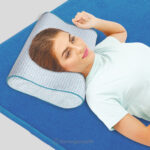
Back pain is the largest single cause of disability in the UK, with lower back pain alone accounting for 11% of the total disability of the UK population as reported by NHS England.
Chronic back pain is characterized by tingling, numbness or painful sensations in the lower back. If it persists for more than 12 weeks, medical help may be required. This is different from acute back pain which comes and goes away within 2 to 6 weeks.
Causes of Chronic Lower Back Pain
There are several conditions that can contribute to chronic back pain.
The most common causes include:
- Thinning of the cartilage inside the spine that occurs in arthritis, leading to pain.
- Spinal stenosis narrows the spinal canal that causes pain.
- Disc problems, such as a herniated or bulging disc cause pain.
- Myofascial pain syndrome which is unexplained muscle pain and tenderness.
- Muscle deconditioning, also called muscle atrophy when the back muscles lack the strength and stability to support, leading to wear and tear and pain.
- Improper posture or body mechanics can stress the spine and strain the soft tissue surrounding it causing pain over a period of time.
- With age, the muscles lose strength which can lead to chronic pain.
- Traumatic events such as accidents can cause chronic back pain.
Chronic Lower Back Pain Management Techniques
NHS England advice exercises to manage chronic back pain. Lack of activity can make the body stiff, muscles and bones weaker, and sleep can be negatively impacted. Due to this, the pain may feel worse.
Physical Therapy for Lower Back Pain
Physical therapy involves manipulation, stretching exercises and pain-relief exercises. They help relieve pain, help the body move better and make daily tasks easier to perform.
Chiropractic Care for Lower Back Pain
NHS England recommends the chiropractic techniques like:
- Spinal manipulation.
- Short, sharp thrusting movements.
- Pulling or stretching the muscles in different directions.
Massage Therapy for Lower Back Pain
Massage therapy is used to help manage back pain. It involves manipulating the soft tissues of the body. This can help relieve chronic back pain.
Acupuncture for Lower Back Pain
Acupuncture is a treatment derived from ancient Chinese medicine. Fine needles are inserted at certain sites in the body that help stimulate sensory nerves under the skin and in the muscles. This results in the body producing natural substances, such as pain-relieving endorphins. A course of acupuncture usually creates longer-lasting pain relief.
Pain relief orthopaedic products
Support braces and posture alignment devices can be used to get relief from the pain.
When to See a Doctor for Lower Back Pain
According to NHS, one should visit a GP when:
- Back pain does not improve after treating it at home for a few weeks;
- The pain restricts day-to-day activities;
- The pain is severe or getting worse over time;
- The pain hampers sleep;
- It’s very hard to move, get out of bed, go to the bathroom, wash or dress.
Conclusion
FAQs
1. What are the best exercises for chronic back pain?
A: The best exercises for chronic back pain are the ones that won’t put too much strain on yourself. Walking, swimming, dancing, yoga or pilates are recommended.
2. What are the symptoms of chronic back pain?
A: The symptoms of chronic back pain may include:
- Constant pain or pain at irregular intervals;
- Soreness in the affected area;
- Difficulty in doing day-to-day activities because of pain;
- Tingling or numbness in the lower back.
3. How is chronic back pain diagnosed?
A: The healthcare professional will check your past medical records and examine your back condition. Your ability to sit, stand, walk, and lift your legs will be thoroughly checked. If the need arises, X-rays, CT scans, MRI scans, blood tests, bone scans and nerve studies will be conducted.
4. What is the prognosis for chronic back pain?
A: The prognosis of chronic lower back pain can be determined by the changes in pain and disability in the initial period. Clinical, work and related activities can contribute to developing chronic lower back pain.
Join us and help create a pain-free world!
-
Countered Lumbar Sacro Belt
£28.99 Select options This product has multiple variants. The options may be chosen on the product page -
Posture Brace
£24.99 Select options This product has multiple variants. The options may be chosen on the product page -
Back Support/Lumbar Corset Belt
£14.99 Select options This product has multiple variants. The options may be chosen on the product page




